Seattle, in the early 1960's; First Students; Formation of the Jun Fan Gung Fu Institute
After Bruce Lee (Lee Jun Fan) left Hong Kong and came to the United States, he eventually took some students who desired to learn Gung Fu. His very first student was Jesse Glover, who has related those early times and experiences with Bruce in an informative and interesting way in his book, Bruce Lee Between Wing Chun and Jeet Kune Do. Jesse Glover was regarded among the earliest students both as Bruce’s personal friend and foremost student. Every so often he would come down to the old basement in Seattle’s Chinatown and work out with the regular class.
Taky Kimura became Bruce’s Assistant Instructor in the Jun Fan
Gung Fu Institute. He held the highest ranking within the school,
of course, and was Bruce’s closest friend and associate. I was
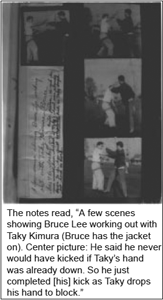 granted membership in Bruce’s school before it was established in
the Chinatown basement location or called the Jun Fan Gung Fu
Institute. In those early days we simply worked out in a student’s
yard, or on playgrounds or school yards, etc. (See published letter
in “Black Belt” magazine, February, 1974: “A Bruce Lee Student
Remembers the Early Days”) After the obtaining of the Chinatown
basement location of the school, I was privileged to be a contemporary
student with Linda Emery who was later to become Linda Lee.
granted membership in Bruce’s school before it was established in
the Chinatown basement location or called the Jun Fan Gung Fu
Institute. In those early days we simply worked out in a student’s
yard, or on playgrounds or school yards, etc. (See published letter
in “Black Belt” magazine, February, 1974: “A Bruce Lee Student
Remembers the Early Days”) After the obtaining of the Chinatown
basement location of the school, I was privileged to be a contemporary
student with Linda Emery who was later to become Linda Lee.
One day Bruce came to my apartment ...at the Holly Park Housing
Project in Seattle while we were trying to find a permanent place to
work out. He expressed some pleasure at seeing some oriental
decorations I had in my living room. He was pleased to see that I
liked things like that, Then we walked over to the Boys’ Club next
door where I was teaching the fundamentals of Judo to some boys
each week. I had told Bruce that he could use the stage area for the
Gung Fu class. But, after looking it over, Bruce decided against it
because he thought there would be too many interruptions and
curious boys around to hold a class there.
It was some time after this that Bruce obtained the old basement
in Chinatown. It was located between Jackson and Dearborn
Streets, and that is where we worked out and where the school
remained for the longest period of its existence. It seems strange to
reminisce now that down those dingy steps in that old basement
was a young man teaching Gung Fu to about twenty or thirty
students who was destined to
become the most highly
regarded and widely known
martial artist of all time. For
a short time thereafter the
school was relocated in the
Seattle University District.
And just prior to this move
Bruce took a trip back to
Hong Kong to visit his
parents, and, of course, his
old school and teacher, Yip
Man, and those he worked
out with. Before his departure
he took us out to an
eight-course dinner in an
upstairs room of the Hong
Kong restaurant in Seattle’s
Chinatown. There was a fish
served head and all, on a big
platter, some cloudy water,
and plenty of rice. Being a
bit squeamish I stuck mainly to the rice, and nibbled at the other
things. I was kind of glad I did, when glancing at my neighbor’s
plate I saw something that looked familiar. It was the cooked,
complete head of a small bird, with beak, eye holes, and all on the
edge of his food! And it was only later that I discovered that the
soup I’d eaten was, true to its name, made from a real bird’s nest!
That is, the “mortar” of the bird’s nest is made by its saliva and this
saliva is used to make “Bird’s Nest Soup.”
Before the school moved to the University District, Bruce took a
trip to California where he met several outstanding martial artists.
Among them was James Lee, who was later to become his ardent
student, and one of Bruce’s best friends. From notes he carefully
took, James Lee eventually produced the book, Wing Chun Kung
Fu. This is one of the clearest and best books available on Wing
Chun - bar none. In fact, it is so plain and direct in its teaching that
those who are looking for some elaborate “secret” to success in
training will pass right over that which would really help them.
James Lee was also the teacher of Gary Dill, a former karate
instructor. Gary told me one
day that he had learned more
in one year with James Lee
than he had learned in eight
years of karate! When Bruce
returned from his California
trip, he was very excited and
enthusiastic — especially
about James Lee. Referring
to their workouts and the
concepts they had discussed
together, Bruce looked really
happy. He smiled and said,
“He’s convinced!” Shortly
after this Bruce’s first book
was produced by James
Lee’s own Oriental Book
Sales. That James Lee was
indeed convinced is evident from his comment in the Foreword to
that book: “Oscar Wilde once said ‘Imitation is the most sincere
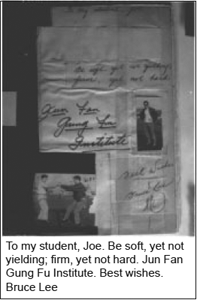 compliment.’ If so, I have paid Mr. Bruce Lee a sincere compliment
by changing all my Gung Fu techniques to his methods....”
compliment.’ If so, I have paid Mr. Bruce Lee a sincere compliment
by changing all my Gung Fu techniques to his methods....”
Bruce inscribed and autographed my copy of this book for me at
the old Chinatown basement school. I still have this treasured copy,
now considered a rare collector’s item. In it he wrote: “To my
student, Joe. ‘Be soft, yet not
yielding; firm yet not hard.’ Best
Wishes, Bruce Lee.”
The only uniform we wore in
those days was a very short black
vest, secured in front with a gold
cord and a Chinese knot. Bruce had
a Chinese lady make some yin/";
yang emblems for us too. Because
the fabric tended to fray, I had my
emblem done commercially so it
would wear better. This was not the
later Jeet Kune Do emblem, but
just the yin/yang itself. Later Bruce
added encircling arrows on the
emblem and on our membership
cards. My membership card was
#0029 and indicated “Permanent
Member.” I still have all of these
things. I can remember seeing
some students just carelessly
leaving their vests hanging around
at that old basement school and I wondered why they didn’t value
them more than that. The complete uniforms some students had
were never worn in class, They were only used for demonstrations
and were considered just the same as owning a tuxedo.
The school later moved to the Seattle “U” District where the
quarters were large and expensive Bruce had living quarters in the
back of this school. One day he invited me to come back and see
his beautiful teakwood furniture which had arrived from Hong
Kong. It had a very high gloss so the finish looked like glass. I
think he was very proud of this furniture, and it really was pretty.
One day Bruce paraded around for us in a coat he said his father
had given him. It was a long coat made of fluffy white fur, and
Bruce looked somewhat like a polar bear in it. It was a beautiful
coat, and Bruce looked like he was really dressed for some cold
weather with it on.
Some visitors came in one day, and after talking with them,
Bruce demonstrated his kick for them. Using me for the target, his
kick whipped out very fast, and I could hear it “pop” right by my
eye. I didn’t flinch though because I knew he was very accurate.
When he saw that I didn’t flinch, his kick came even closer, and
each time there was a popping sound right by my eye. Another
time he demonstrated his one-inch punch. He placed a chair a few
feet behind a young man who was visiting the school, then with
just a slight movement he struck the man on the chest. The effect
was startling! It was like a big hand had slapped the man on his
chest very hard, and he shot backward into the chair, and the chair
skidded on the floor! Evidently the man was duly impressed
because he joined Bruce’s school.
One of my friends and I worked out quite a lot together, and he
had become extremely fast with a particular punch. He had long
arms and he would often fire that punch at me so fast that he would
hit me on the nose with his palm. He didn’t hit hard, but it got so
that I almost got annoyed because most of the time I couldn’t block
his punch.
One day this student decided to try this punch on Bruce. This,
by the way, was unethical because we were not allowed to hit each
other in class. We were always told to “come two inches from our
partner and stop.” Thus, there was a surprise for Bruce when this
student actually hit him during a sparring demonstration in class.
Compounding this insult was the fact that there was a karate man
watching who had previously challenged Bruce to a fight, Bruce
had beaten this man in about 11 seconds in this serious fight. I
happened to be absent from class when my friend hit Bruce but he
walked up to me later and told me what had happened. He was
laughing about it and said he had hit Bruce twice! I asked him
what Bruce had done, and he said Bruce just started using “sticking
hands” (Chi-Sau) on him. “Then,” he said, “I couldn’t do anything
— he just ‘ate me up!’” He said the first time he hit Bruce that
Bruce responded by sweeping his feet out from under him, and the
second time Bruce kicked him in the groin. After class, he said,
Bruce called him over, and he said, “I knew what was coming.”
Bruce told him, “The next time you hit me in front of that karate
guy. I’m really going to work you over.” I asked another student
who had seen it if it looked like Bruce had hurt my friend. “Yeah!”
he exclaimed, “it hurt me!” Bruce was very good at getting his
point across like that.
On my very first day in his class, some time before this incident,
I noticed two students practicing an arm-banging exercise called
“sam-sing” which was designed to toughen the forearms. The
students slammed their forearms together over and over in this
exercise. I decided to try it, and I practiced with an older student. I
really wasn’t trying to be a tough guy, but Bruce didn’t know that
since it was my first day there, and to top it off, the other student
quit since my arms just happened to be tougher than his were. So
Bruce walked up to me and said, “Let’s see how long you can go
with me!” So we started banging our forearms together. Then we
started going harder and harder. All at once Bruce’s fist flew up
and he struck me in the right temple so hard that the following
week every time I would eat I could feel the bruise hurting me.
“You didn’t get your hand up in time,” Bruce said pleasantly. Still I
did not get the hint that he was letting me know that I better stop.
So I kept hitting his forearms, and then I noticed he really started
pouring it on! So I thought, “I better stop since he’s the teacher,”
and I said, “That’s enough.” Bruce looked at me, and said very
bluntly, “Don’t be a hero. If it hurts, stop, or I’ll break your arm!”
After class he drove back to Seattle with me and told me he
admired me for practicing at my age. (I was thirty-two when I
began training under Bruce.) I asked him that very first day on the
way back to Seattle, “How long does it take to learn gung fu?”
The memory of his reply jolted me when I viewed the reports and
pictures of his funeral a few years later. Bruce said, “You never
quit learning until they close the lid on your coffin.” How little did
we realize his own words were to come true so soon for him.
When we arrived in Seattle, Bruce took me to the Tai Tung Cafe
in Seattle’s Chinatown, bought my dinner, and took my little spiral
notebook and drew some gung fu stances in it for me. While we
were discussing gung fu, he reached across the table to demonstrate
his arm-wrestling. I grabbed his hand, and without our arms
touching the table we started. But it was no contest! I felt like I
would feel if I’d grabbed hold of a machine that was turning!
Bruce turned my arm so fast I felt completely helpless to stop him.
In fact, I felt like my arm would break if I tried to stop his force.
I recall once when my friend, Lee Norman, told Bruce that he
had met a boxer who boasted that he could probably beat Bruce or
knock him out. Bruce just looked at Norman and asked “Do you
think he can do it?” Norman said, “No, I don’t. I just thought I’d
have him come down so you could show him a few things.” But
Bruce said, “You’re right, he can’t. What you think is all that
matters. If he wants to kill himself, let him go ahead, but don’t
invite him to do it!”
Bruce always stressed that it was the person who talked who
didn’t really know, and the person who did not talk who did know
because he did not have to go around proving it to himself and
everyone else. When Bruce had his fight with the karate man, he
told us about it. We were in his class. But when people would
come up to him on the University of Washington campus and say,
“Hey, did you know that ________ has a black eye?” Bruce would
just say, “Oh, really?” But he wouldn’t tell them he had given it to
him. The karate man thanked Bruce for that and joined his class,
However, he did not last long because Bruce said that he just
wanted to learn some things to teach his own karate students. This
same man had bragged to me how he had challenged Bruce to fight
him, and Bruce had turned him down. And this bragging took place
before I even knew Bruce. Nor did I know the karate man. So I
didn’t know what he was bragging to me for. Later he made the
mistake of confronting Bruce on the University of Washington
campus. Bruce said the man walked right up to him and stared
right in his face. Then he reached out, shoved Bruce aside and
walked past him. Bruce said to us, “As long as he talked, I just let
him talk. But when he put his hands on me, then I accepted his
challenge.” He fought the man at the Seattle YMCA in a handball
court. According to Ed Hart, who kept time on his watch, Bruce
beat him in 11 seconds.
Martial arts schools and teachers were quite rare in those days,
so one day when I happened to go into a Health Studio in the
White Center area of Seattle I was quite surprised to see a karate
class being advertised. When I asked about it, the owner of the
Health Studio apparently was determined to impress me. He told
me the teacher was a black belt and very capable — in fact, he
could probably even handle Bruce Lee! I had never seen an actual
karate class before, and I really wanted to watch it. I called Taky
Kimura and he contacted Bruce, and that night the three of us went
to watch.
When we first walked in, Bruce noted the writing on the backs
of the uniforms and commented, “This is very good, it’s what I
started out in.” We just sat down and watched. Pretty soon the
teacher, seeing Bruce was oriental, asked him if he taught. Bruce
replied, “Well, if you hadn’t spoken to me, I wouldn’t have said
anything, but since you asked...” He then began discussing concepts
of martial arts with the young man. Bruce told the teacher to
press down on his hand, and he did so, and Bruce said, “Press
harder.” I then saw Bruce’s hand tremble slightly under the pressure,
then up it came, and he touched the teacher on the chest just
like he had told him he would.
We went out that night with the young teacher after his class
dismissed and stopped for coffee and soft drinks for Bruce (since
he did not drink coffee). While we continued discussing martial
arts techniques, Bruce said to him, “I will show you that I will poke
your eye, and you cannot stop me.” (Of course he meant this as a
demonstration, not a threat to the young man.) So, when we went
outside, Bruce had him stand with his hand all prepared to block,
and Bruce stood back with his own hand clear down by his thigh.
Suddenly his hand shot toward the man’s eyes and back out again.
The man’s hand barely moved to block before it was all over. Then
Bruce did it two more times, but by the time the man’s hand could
even hardly move, Bruce had completed his own eye strike. Later I
dropped by the Health Studio and the same man who had tried so
hard to impress me before told me, “The karate teacher came back
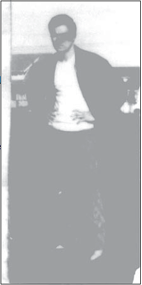 and said, ‘I’m nothing compared to that guy! He’s like a 6th degree
karate man!’”
and said, ‘I’m nothing compared to that guy! He’s like a 6th degree
karate man!’”
After Bruce took his trip to California and met James Lee and
other martial artists such as Ed Parker and Wally Jay, he began to
have an interest in going to California. Thus the school’s existence
in the “U” District of Seattle was short-lived, and Bruce began
traveling more. By this time though, I would catch the ferry back to
Seattle and go to work out in the old Chinatown basement as the
school had again located there. This was the original and same
basement location of Jun Fan Gung Fu Institute. All there was to
indicate that it was a gung fu school was an old building with
dingy steps leading down to the basement. If one looked closely, he
could see a yin/yang emblem as he started down the steps. But
there was nothing at street level to suggest that there was a gung fu
class going on there.
Taky Kimura was in charge as Bruce’s assistant, of course, as he
had been for a long time, in fact since the beginning of the formal
Jun Fan Gung Fu Institute. Bruce’s presence at the school was less
frequent by this time, but it was good to see him when he could be
there. This was the beginning of the end for Seattle, as far as
Bruce’s personal teaching was concerned. His new life was beginning
to open up for him in California.
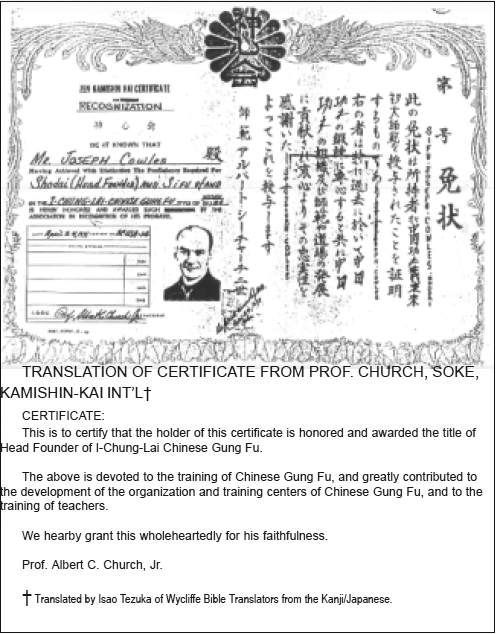 1978. It is pictured in this booklet [website]. (Please note the art is not my
invention, only the method of teaching and some techniques are my
own.) The late Dr. Church also granted membership in Kamishin-";
Kai International to me as such, (In the Photostat the name IChung-";
Lai refers to the name of the Kwoon (School); the style of
Gung Fu taught in this school is “Wu-Wei” (or, as in Cantonese,
“Mo-Wai”). The name I-Chung-Lai (presently termed “Cheung-";
Loi-I”) refers to the Biblical Gospel as taught in Holy Scripture.
Dr. Albert Church, Jr. is considered one of “the founding fathers
of martial arts in America.” “Black Belt Magazine”, April, 1977.
The Certificate of Recognition given to me by Dr. Church
1978. It is pictured in this booklet [website]. (Please note the art is not my
invention, only the method of teaching and some techniques are my
own.) The late Dr. Church also granted membership in Kamishin-";
Kai International to me as such, (In the Photostat the name IChung-";
Lai refers to the name of the Kwoon (School); the style of
Gung Fu taught in this school is “Wu-Wei” (or, as in Cantonese,
“Mo-Wai”). The name I-Chung-Lai (presently termed “Cheung-";
Loi-I”) refers to the Biblical Gospel as taught in Holy Scripture.
Dr. Albert Church, Jr. is considered one of “the founding fathers
of martial arts in America.” “Black Belt Magazine”, April, 1977.
The Certificate of Recognition given to me by Dr. Church
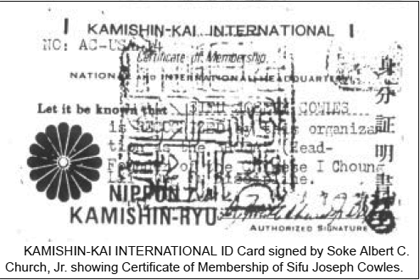 is of a personal nature. It does not mean that Wu-Wei Gung Fu is under
the sponsorship, ranking system, jurisdiction or regulation of
Kamishin-Kai International.
is of a personal nature. It does not mean that Wu-Wei Gung Fu is under
the sponsorship, ranking system, jurisdiction or regulation of
Kamishin-Kai International.